Mad Max Review
While it would be easy to disregard Mad Max as another disposable entry in the Ubisoft “do all of the things” open world design philosophy, there are a few key differences that, for me, set it apart. I have always been someone who just didn’t bother with most of the side stuff in games like Far Cry 4, Shadow of Mordor or the Assassins Creed series (with the notable exception of IV with its clever ship-upgrading system). The rewards you got for completing the optional side activities typically didn’t justify the tedious task of completing them. I think this is also in part because the stories of these games generally don’t tie in well with the side content.
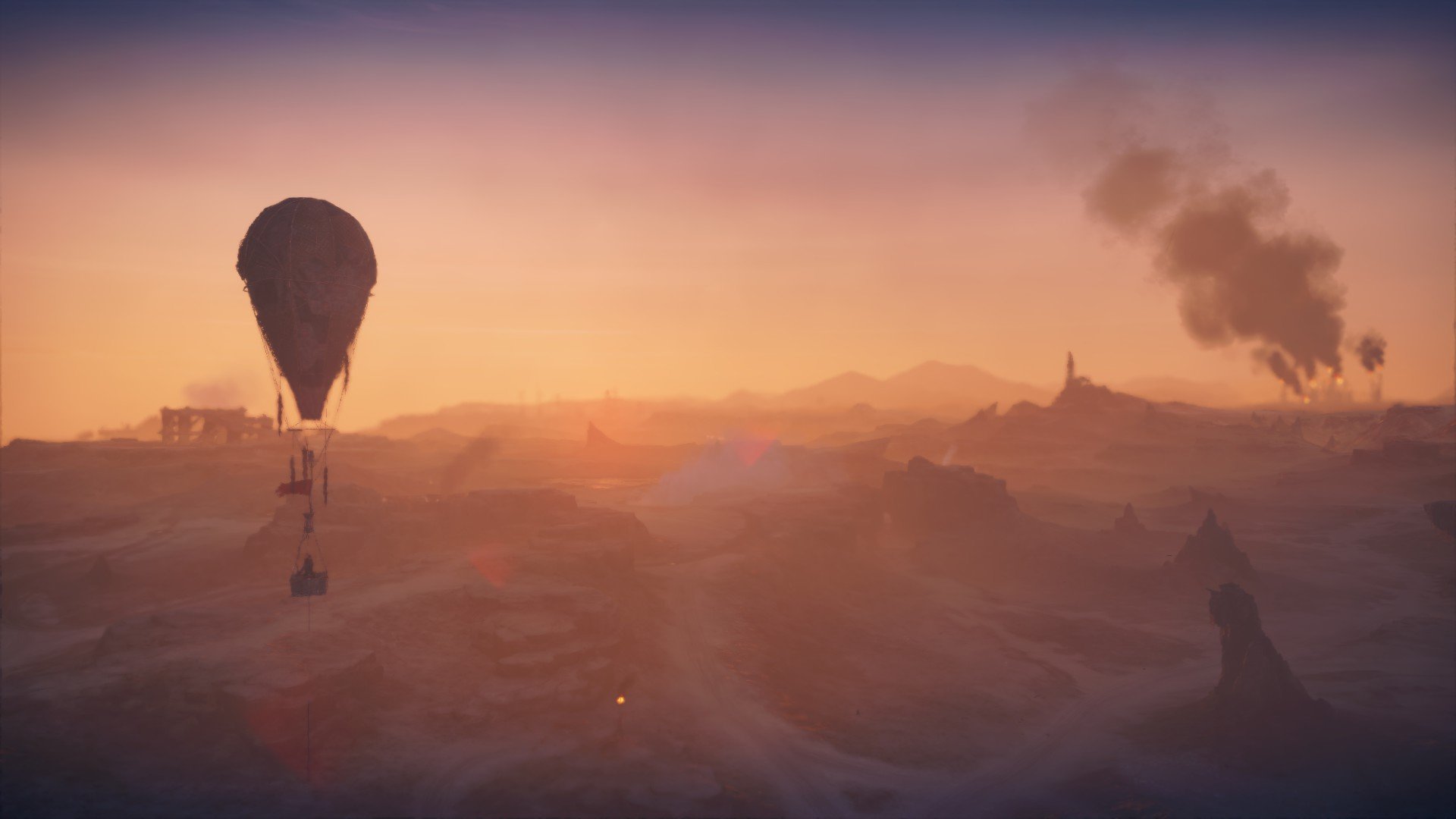
Hot-air balloons are Mad Max’s version of ‘reveal the activities in this area’
There is a nagging disconnect that usually bothers me when going through a game with any semblance of narrative urgency that stems from going off and piddling around helping locals deal with problematic wildlife or running other assorted errands for them. Mad Max manages to largely avoid these trappings; the game’s story is about building up a car that is good enough to let Max drive across a huge, barren wasteland. Whether you are playing the story or roaming around completing side content, the gameplay is generally focused on completing tasks that will let Max upgrade his car. So even though I am usually very comfortable skipping side content in superficially comparable open world games, I actually found myself compelled to go off and complete the optional open-world stuff in Mad Max; sadly, the stuff itself lacks variety and substance, but I’ll get to that later.
While the story does give reasonable justification for Max to be driving around punching scavengers, smashing up their cars and picking up pieces of metal, that doesn’t mean it’s a very interesting story in its own right. At the start of the game, Max loses his prized vehicle the Black on Black after a run-in with a nasty fellow named Scaberous Scrotus. Soon after you meet by chance a disfigured fellow who happens to be a car-worshipping expert mechanic who believes Max is a saint fulfilling some kind of prophecy. The mechanic, named Chum Bucket, agrees to help Max by granting him access to an initially basic vehicle, installing upgrades on it, and acting as his assistant whenever Max is driving the Magnum Opus, his primary car. From this point, you will drive between strongholds, helping their leaders in exchange for the chance to improve Max’s ride.
Chum Bucket adds quite a bit to the game, thanks to good voice acting and his peculiar way of warning Max about various goings-on in the wasteland. After a while you will start to get tired of hearing the same lines over and over, but I would still say that Chum Bucket is a positive addition to the game. You can ask him to repair your car any time, or he will do this automatically whenever Max gets out of the vehicle. He also helps out during vehicular combat, firing harpoons and thunder-poons (exploding spears) from the back of the Opus at enemy vehicles, while you try and crash into them.
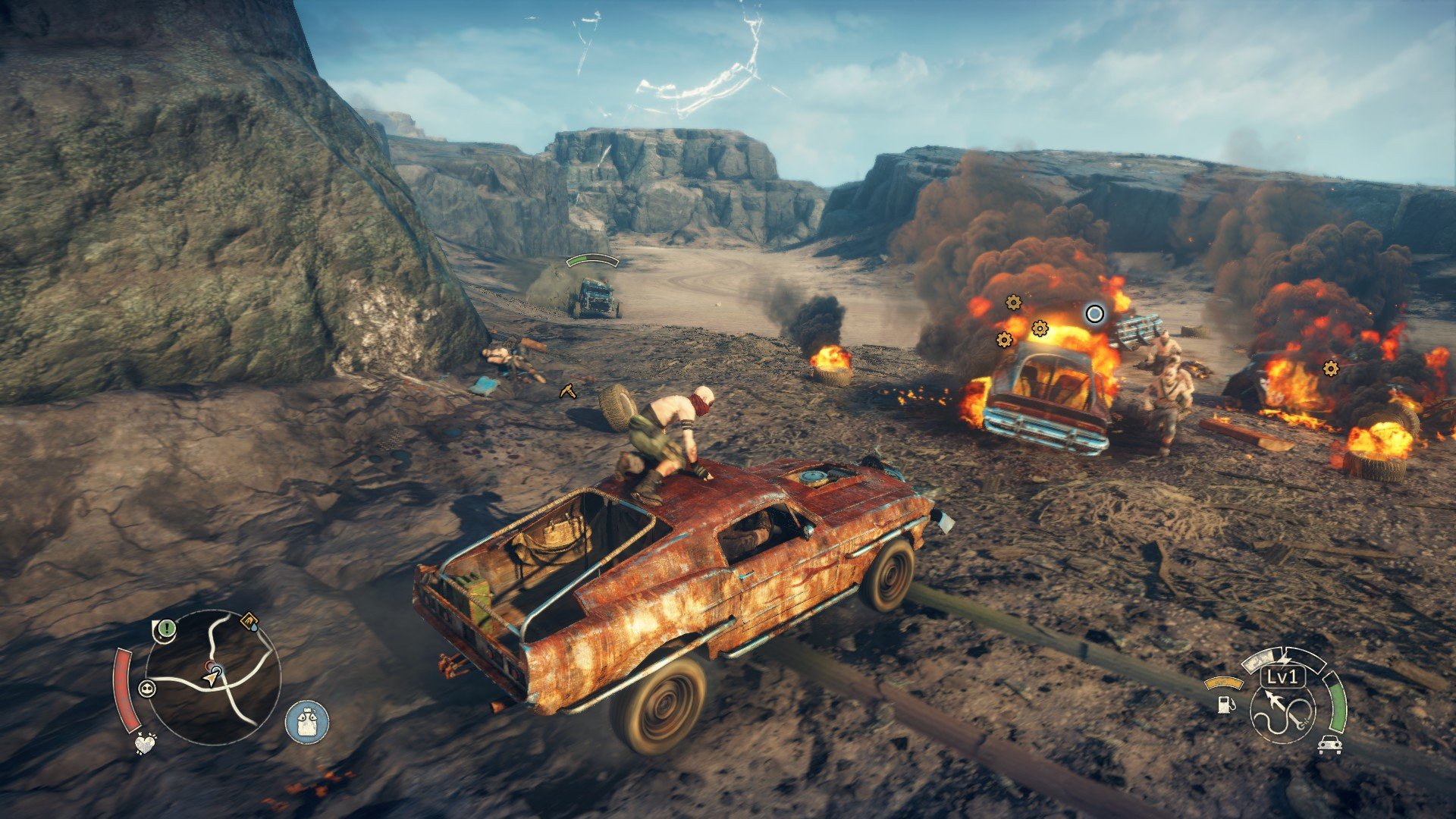
War-boys will climb onto Max’s car if they get close enough
The harpoon merits additional explanation, because it ultimately serves as one of the core features of the game’s driving sections. The harpoon is used to tear down structures, but also during hostile vehicular encounters. You can slow down time and aim at a individual piece of an enemy vehicle, and once you have it fully upgraded, you can rip off tires, bumpers, doors, and even pull enemies out of the driver’s seat, sending them flopping along the ground behind you until you release them.
The car combat works great in the wide-open spaces of the game map, especially when trying to bring down convoys which are composed of a large number of vehicles. These can turn into lengthy chases that require you to use your abilities and driving skills in smart ways if you want to survive or even stay in the chase for long. Car combat does become clumsy and frustrating in the few instances where you are forced to fight in close-quarters, due to the loose handling and limited turn radius of the cars; fortunately these instances are few and far between.
If the Magnum Opus takes too much damage, you have a few seconds to leap out, at which point Chum Bucket will start repairs. If you previously pulled an enemy driver from his car, you can commandeer the now-empty vehicle and continue smashing into enemies while your car is repaired. If there aren’t any empty vehicles around, remaining enemy vehicles will try and run Max over; if you dodge out of the way for long enough, or take out their tires with your shotgun, they will eventually stop their cars and the drivers will get out and attempt to finish Max in hand-to-hand combat.
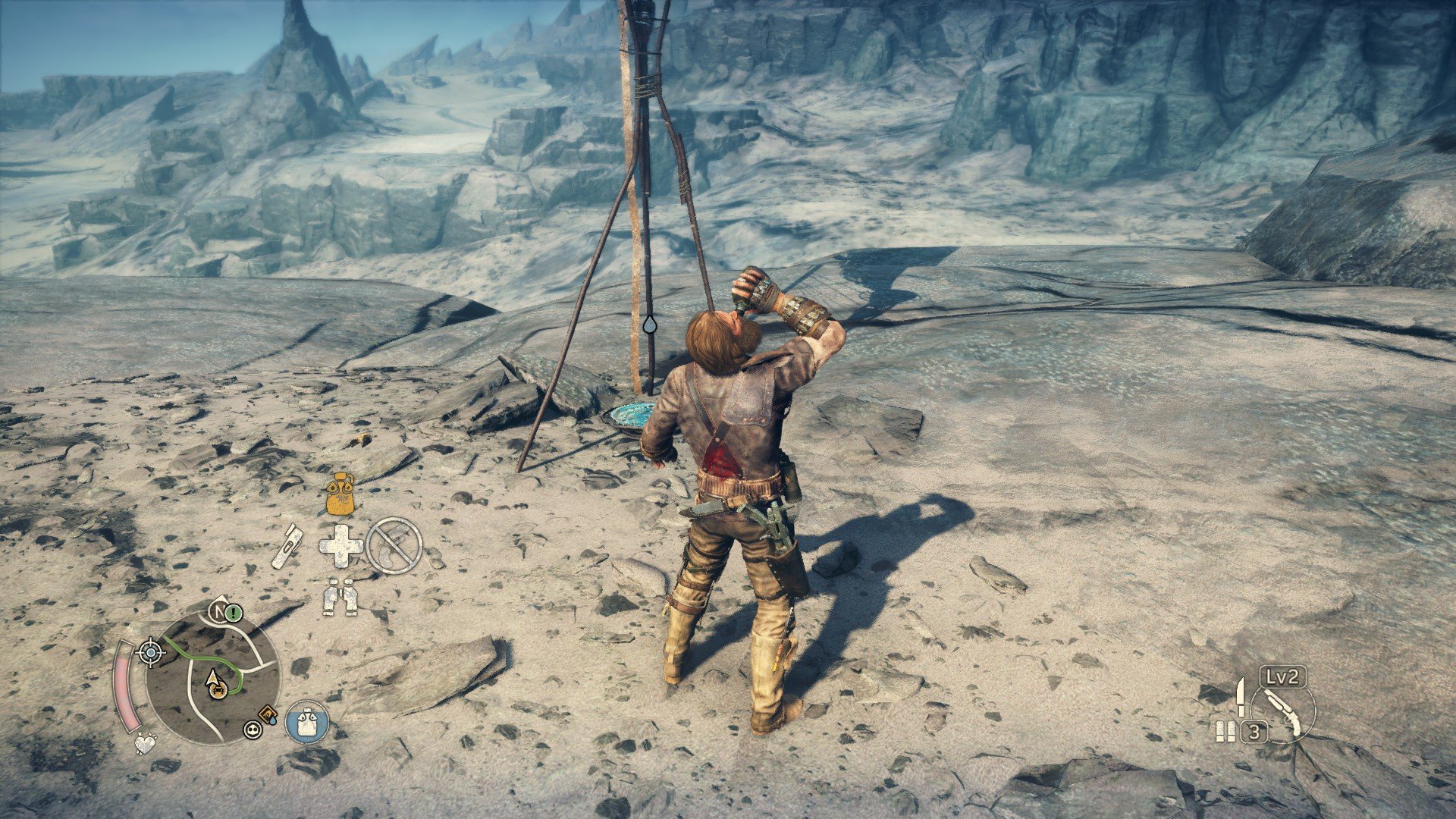
Chugging water is one of the few ways to regain health
Mad Max is another game that utilizes the now commonplace two button attack/counter melee combat system introduced in the Batman Arkham games, and its execution of the system is middle-of-the-road. The combat feels fairly meaty and brutal, but transitional animations can be a bit jerky and countering enemy attacks can feel imprecise. Enemy variety is pretty good however, with many fights later in the game mixing faster enemies who can only be countered with slow-hitting brutes who require strong attacks in order to break their defenses. If you get a good combo going, Max will eventually enter “Fury” mode which lets him ignore these special enemy traits and just punch everything with meatier sounds and faster animations leading to moments of brutal glee. You can also whip out your shotgun during combat to blast an enemy, or pick up a melee weapon and use it for a bit until it breaks.
Whether you are smashing up cars or punching people, the usual objective outside of story missions is to obtain scrap so that you can upgrade Max and his ride. There are many ways to go about collecting scrap, some of which are more effective than others. You can run around to the bazillion scavenging locations that are marked on your map, but these only provide tiny amounts of the material. You can pick it up off the ground after destroying enemy vehicles or ‘Totems’ which are meant to mark the territory of Scrotus, the main Villain; but again, this won’t get you very far, and you will quickly become frustrated with having to go up to every single bit of the stuff and hold down a button to collect it.
The main way in which you will accumulate scrap is by taking over the larger camps that are scattered around the map. Each camp will have defenses, which you can usually eliminate by charging in and driving through them/dragging them down with your harpoon, or you can find a good vantage point at a safe distance and eliminate the threats with your harpoon. Eliminating perimeter defenses is good fun, however to take over the camp, you will need to go in on foot and fight a bunch of enemies and blow some stuff up. These camps vary in quality from interesting and atmospheric to tedious and frustrating. Some take place in neat locations like re-purposed grain silos or abandoned ship hulls, while others are just a hodge-podge of metal pieces thrown together.
The objectives in the camps vary from having to blow up some stuff or kill all of the fighters; each territory has a ‘Top Dog’ camp where there is a sort of boss-fight at the end. These mini-boss fights are all identical and pathetically easy, feeling like a missed opportunity to add some variety into the mix. Once you clear out a camp, it will be populated by workers from the nearest stronghold, and will supply you with steady shipments of scrap. This is the best way to reliably get a lot of the stuff, as each camp you take over increases the amount you get with each delivery. You can also capture scrap-transport vehicles or venture out during the seemingly endless storm to try and catch scrap-crates that suddenly appear as means of obtaining some quick resources, but these are situational and not as reliable.
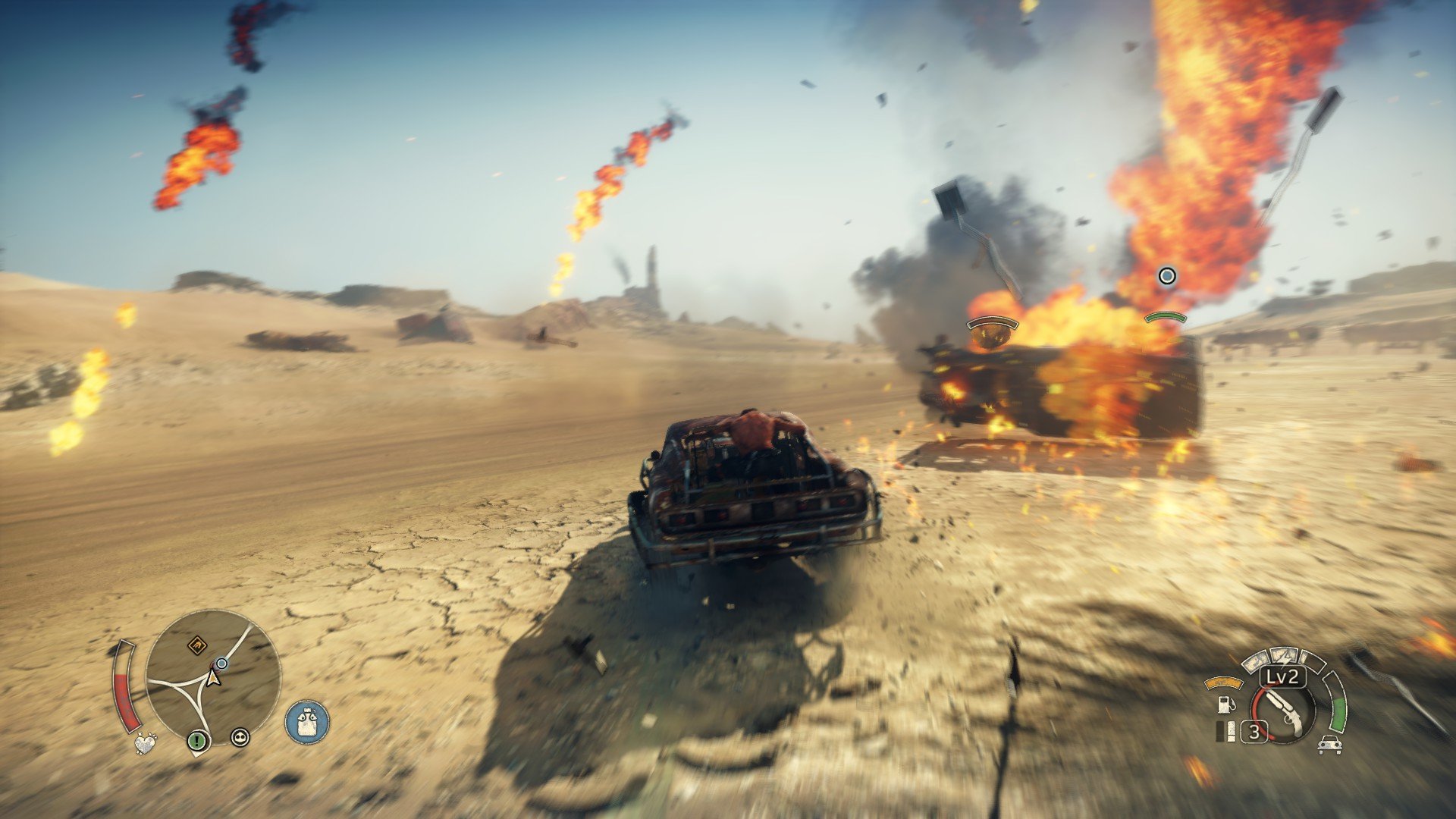
An Avalanche game without explosions wouldn’t be a Avalanche game at all
The main story missions are actually spread quite thin. After the initial stretch where you learn the game’s basics, you will either have to drive to a more difficult area of the map to start the next plot-progressing event, all but forcing you to get upgrades, or the game will explicitly tell you that you need to go do some of the side content before you can progress. The story missions are rather underwhelming for the first while, but they do pick up later in the game, bringing you to some memorable locations and even managing to build some tension at times.
If you get tired of repeating the same side activities over and over but aren’t yet good enough to tackle the next story mission, there are lots of optional side-quests that are provided by stronghold leaders. These are often more interesting than the story missions, requiring you to explore some interesting places like an abandoned subway network or a church that has been totally buried by the sand.
One thing that helps elevate these missions and offsets the repetition is the fact that Mad Max is one of the most visually stunning games to release this year. Even though the map is a wasteland, there is a surprising amount of visual variety to be found. Early areas of the game take place in a dried-up sea bed with huge freighter wrecks partially buried in the sand. As you explore, you’ll go through abandoned industrial areas, a huge desert that is great fun to drive around in, and a sort of Hot-spring/sulphur area reminiscent of Yellowstone Park in the States. An abandoned airport you drive through during one story mission brings the weird imagery of Spec Ops: The Line to mind. Excellent lighting and huge draw distances combined with a surprising amount of fine detail make Mad Max one of the best looking open worlds around.
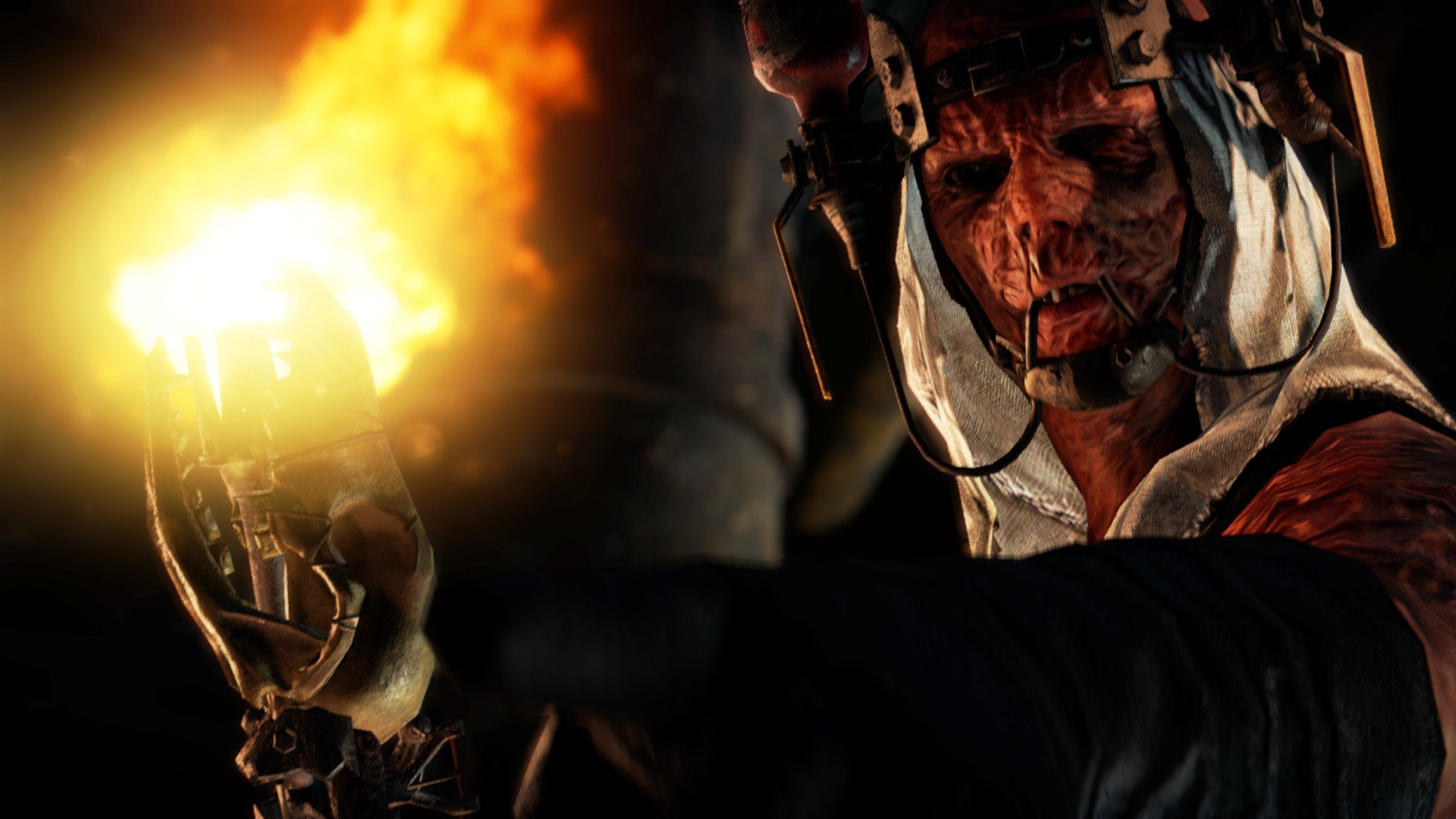
Deep Friah appears to have come by his name honestly
To improve matters even further, the game runs like an absolute dream. I didn’t experience a single noticeable frame rate drop, stutter or crash in the twenty odd hours I spent with Mad Max, which is impressive given the amount of explosions that occur on a regular basis. And the explosions aren’t just any explosions, they are Avalanche Studios explosions, with a magical blend of visual and auditory feedback that makes them incredibly satisfying. The sound is satisfying in general, with the Opus’ engine roaring mightily as you tear across the wasteland, Max’s fists crunching meatily as they impact on a scavenger’s face, and the occasional electrical sandstorms that blow in sounding every bit as fierce as they are. I did experience some minor audio bugs in one area of the map, but generally things worked brilliantly.
It would be easy to nit-pick Mad Max to death for its repetitive design, flimsy plot, sometimes painfully slow upgrade progress, and Max’s pathetic little jump. However, when the chips are down you have a game that is just a lot of fun to play, even when you are doing the fairly mundane side tasks. The game plays well, runs well, and doesn’t make you worry about whether you should really be spending thirty minutes chasing down a convoy in place of going off to do the next story mission. Instead, it actively encourages you do deviate from the main path, and you will probably find yourself gleefully doing so, constantly getting distracted by scrap-transports, camps, convoys and scavenging locations; even when you tell yourself its finally time to drive to the next story quest marker.
